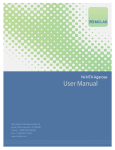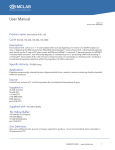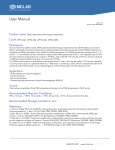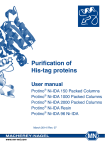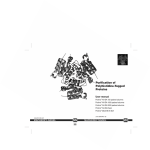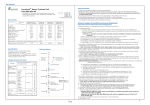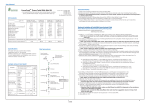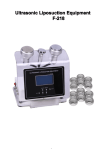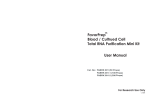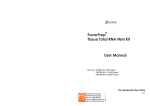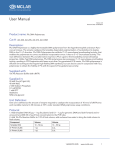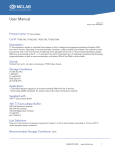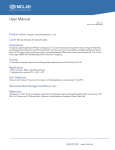Download Ni-NTA Agarose
Transcript
Ni-NTA Agarose User Manual 384 Oyster Point Blvd, Suite 15 South San Francisco, CA 94080 Phone: 1 (888) MCLAB-88 Fax: 1 (650) 872-0253 www.mclab.com Contents Introduction ----------------------------------------------------------------------- 3 Cell Lysates Preparation ------------------------------------------------------ 3 Insect Cell Lysate Preparation ----------------------------------------------- 4 Mammalian Cell Lysate Preparation --------------------------------------- 5 Protein Purification—Native Conditions ----------------------------------- 5 Protein Purification—Denaturing Conditions ----------------------------- 6 Protein Purification—Hybrid Conditions ----------------------------------- 7 Recharging Ni-NTA Resin ----------------------------------------------------- 7 Recipes ---------------------------------------------------------------------------- 8 Troubleshooting ------------------------------------------------------------------ 9 Revised November 2015 mclab.com 2 Ni-NTA Purification MCLAB's Ni-NTA agarose beads are designed for high quality purification of 6xHis-tagged recombinant proteins expressed in bacteria, insect and mammalian cells. Ni-NTA agarose beads are widely used for protein purification due to their high affinity and selectivity for recombinant fusion proteins that are tagged with six tandem histidine residues. Furthermore, the method of purification is easy and simple to use. Proteins of interest can be purified under native, denaturing, or hybrid conditions. Proteins bound to Ni-NTA resincan be eluted with low pH buffer or competitive binding of molecules such as imidazole. Native Versus Denaturing Conditions: Purify under native conditions if your protein of interest is soluble in the supernatant after lysis and preservation of protein activity is integral for downstream applications. Purify under denaturing conditions if your protein of interest is insoluble in the supernatant after lysis or protein activity is not important. Purify under hybrid protocol if your protein of interest is insoluble in the supernatant after lysis, but protein activity is important. Prepare lysate and columns under denaturing conditions. Use native buffers for wash and elution steps for protein refolding. Note that this is a general protocol and may not work for all proteins. Cell Lysates Preparation Materials: Buffer Recipes can be found in page 9 - Native Binding Buffer for lysates preparation under native conditions - Sonicator - 10 µg/ml RNase and 5 µg/ml DNase I - Centrifuge - Sterile, distilled water - SDS-PAGE sample buffer - Guanidinium Lysis Buffer for lysates preparation under denaturing conditions - Lysozyme for bacterial cell lysates preparation - Bestatin or leupeptin for mammalian cell lysates preparation The following instructions for lysate preparation and purification can be scaled up or down depending on user’s preference. This manual exemplifies lysate preparation from a specific amount of starting material and purification using 2 ml resin. Bacteral Cell Lysate Preparation—Native Conditions - Harvest bacterial cells from a 50 ml culture by centrifugation at 5000 rpm for 5 minutes. Resuspend the pellet in 8 ml of Native Binding Buffer. - Add 8 mg lysozyme and incubate on ice for 30 minutes. - Sonicate the solution on ice with a microtip, using six 10-seconds bursts at high intensity with a 10-second cooling period between each burst. - Optional: If lysate is very viscous, add RNase A (10 µg/ml) and DNase I (5 µg/ml) and incubate for 10-15 minutes on ice. - Pellet down the cellular debris in the lysate through a 15 minutes centrifugation at 3,000 x g. The supernatant should then be transferred to a new container. - Prepare 5 µl of the lysate for SDS-PAGE analysis and store the remainder on ice or frozen at -20 ºC for later use. mclab.com 3 Bacterial Cell Lysate Preparation—Denaturing Conditions - Equilibrate the Guandinium Lysis Buffer, pH 7.8 to 37 ºC. - Harvest bacterial cells from a 50 ml culture by centrifugation at 5000 rpm for 5 minutes. Resuspend the pellet in 8 ml of Guanidinium Lysis Buffer. - Mix the cells gently for 5-10 minutes at room temperature for thorough cell lysis. - Sonicate the solution on ice with a microtip, using three 5-second bursts at high intensity. - Pellet down the cellular debris in the lysate through a 15 minutes centrifugation at 3,000 x g. The supernatant should then be transferred into a new container. - Prepare 5 µl of the lysate for SDS-PAGE analysis and store the remaining lysate on ice or frozen at -20 ºC for later use. Note: Samples containing Guanidinium Lysis Buffer need to be diluted, dialyzed or TCA precipitated prior to SDS-PAGE to prevent SDS precipitation. Insect Lysate Preparation The following protocols are for baculovirus-infected cells and are intended to be generic. They should be optimized for your specific cell lines. Large scale protein expression should be carried out when the time point of maximal expression has been determined. Generally, protein expression is performed in 1 liter flasks seeded with cells at a density of 2 x 106 cells/ml in a total volume of 500 ml. The cells are infected with high titer viral stock at an MOI of 10 pfu/cell. At maximal expression, cells are harvested in 50 ml aliquots and pellet down by centrifugation and stored at –80 ºC until needed. Insect Cell Lysate Preparation—Native Conditions - Prepare 8 ml Native Binding Buffer containing 0.5 µg/ml of leupeptin. - Harvest the cells from a 50 ml culture by centrifugation at 5000 rpm for 5 minutes. Resuspend the pellet in 8 ml of Native Binding Buffer containing 0.5 µg/ml of leupeptin. - Cells are lysed by freezing and thawing using liquid nitrogen or dry ice/ethanol bath and a 42 ºC water bath. - Shear the DNA by passing the lysate through an 18-gauge needle four times. - Pellet down the cellular debris in the lysate by 15 minutes centrifugation at 3,000 x g. The supernatant should then be transferred to a new container. - Prepare 5 µl of the lysate for SDS-PAGE analysis and store the remaining lysate on ice or frozen at –20 ºC for later use. Insect Cell Lysate Preparation—Denaturing Conditions - Harvest the cells from a 50 ml culture by centrifugation at 5000 rpm for 5 minutes and resuspend the pellet in 8 ml Guanidinium Lysis Buffer. - Pass the lysate through an 18-gauge needle four times. - Pellet down the cellular debris in the lysate by 15 minutes centrifugation at 3,000 x g. The supernatant should then be transferred to a new container. - Prepare 5 µl of the lysate for SDS-PAGE analysis and store the remaining lysate on ice or frozen at -20 ºC for later use. Note: Samples containing Guanidinium Lysis Buffer need to be diluted, dialyzed or TCA precipitated prior to SDS-PAGE to prevent SDS precipitation. mclab.com 4 Mammalian Cell Lysate Preparation The following protocols for mammalian expression are intended to be generic and should be optimized for your specific cell lines. Expression of your specific recombinant protein requires between 5 x 106 and 1 x 107 cells. Seed and grow the cells in the appropriate medium until they are 80-90% confluent. Trypsinization is used to harvest the cells. Freeze cell pellet in liquid nitrogen and store at -70 ºC for later use. Mammalian Cell Lysate—Native Conditions - Resuspend the cell pellet in 8 ml Native Binding Buffer containing protease inhibitors such as bestatin and leupeptin if necessary (this depends on the cell line and expressed protein). - Cells are lysed by freezing and thawing using liquid nitrogen or dry ice/ethanol bath and a 42 ºC water bath. - Shear the DNA by passing the lysate through an 18-gauge needle four times. - Pellet down the cellular debris in the lysate through a 15 minutes centrifugation at 3,000 x g. The supernatant should then be transferred to a new container. - Prepare 5 µl of lysate for SDS-PAGE analysis and store the remaining lysate on ice or frozen at –20 ºC for later use. Mammalian Cell Lysate Preparation—Denaturing Conditions - Resuspend the cell pellet in 8 ml Guanidinium Lysis Buffer. - Shear the DNA by passing the lysate through an 18-gauge needle four times. - Pellet down the cellular debris in the lysate through a 15 minutes centrifugation at 3,000 x g. The supernatant should then be transferred to a new container. - Prepare 5 µl of the lysate for SDS-PAGE analysis and store the remaining lysate on ice or frozen at -20 ºC for later use. Note: Samples containing Guanidinium Lysis Buffer need to be diluted, dialyzed or TCA precipitated prior to SDS-PAGE to prevent SDS precipitation. Protein Purification—Native Conditions Protein purification should be used with prepared Native Binding, Wash, and Elution buffers, columns and cell lysate under native conditions. Materials: Buffer Recipes can be found on page 9 - 3 M imidazole - NaOH - HCl - Prepared Ni-NTA columns with native buffers - Sterile, distilled water - Native Purification Buffer - Lysate prepared under native conditions Note: Do not use strong reducing agents or strong chelating agents. These agents, such as DTT, EDTA or EGTA reduce nickel ions in the resin or strip the nickel from the columns. Ni-NTA Column Preparation - Resuspend Ni-NTA agarose slurry in a bottle container. - Pipet 1.5 ml slurry into a 10 ml purification column and allow resin to settle by gravity. - Add 6 ml of sterile distilled water and resuspend resin. - Let the resin settle by gravity and gently aspirate the supernatant. - Add 6 ml of Native Binding buffer for purification under native conditions. - Resuspend the resin and let the resin settle by gravity. - Gently aspirate the supernatant. - Repeat step 5 through 7. mclab.com 5 Note: Prepared columns containing resin can be stored at room temperature with the addition of 0.02% azide or 20% ethanol and capped or parafilmed. Protein Purification—Native Conditions Protocol - Add 8 ml of lysate prepared under native conditions to a prepared Purification Column containing resin. - Allow binding to take place for 30-60 minutes with gentle agitation to keep resin suspended in the lysate solution. - Let resin settle by gravity and gently aspirate and save the supernatant at 4 ºC for SDS-PAGE analysis. - Wash resin with 8 ml of Native Wash Buffer. Allow resin to settle by gravity and carefully aspirate and save the supernatant at 4 ºC for SDS-PAGE analysis. - Repeat Step 4 three more times. - Elute the protein with 8-12 ml of Native Elution Buffer. Collect the eluate in 1 ml fractions and analyze on SDS-PAGE. Note: The eluted fractions can be stored at 4 ºC. Add glycerol to the fractions if –20 ºC storage is required. Protease inhibitors should be added for long term storage. Resins can be used again for purification of the same recombinant protein. Wash the resin with 0.5 M NaOH for 30 minutes and resuspend in a suitable binding buffer. Refer to page 8 to recharge resin. Protein Purification—Denaturing Conditions Protein purification should be used with prepared Denaturing Binding, Wash, and Elution buffers, columns and cell lysate under denaturing conditions. Materials - Prepared Ni-NTA Agarose with denaturing buffers - Cell Lysate prepared under denaturing conditions - Denaturing Binding Buffer - Denaturing Wash Buffer - Denaturing Elution Buffer Ni-NTA Column Preparation - Resuspend Ni-NTA agarose slurry in a bottle container. - Pipet 1.5 ml slurry into a 10 ml purification column and allow the resin to settle by gravity. - Add 6 ml of sterile distilled water and resuspend the resin. - Let the resin settle by gravity and gently aspirate the supernatant. - Add 6 ml of Native Binding buffer for purification under Denaturing Conditions. - Resuspend the resin and let the resin settle by gravity. - Gently aspirate the supernatant. - Repeat step 5 through 7. Note: Prepared column containing resin can be stored at room temperature with the addition of 0.02% azide or 20% ethanol and capped or parafilmed. Protein Purification—Denaturing Conditions Protocol - Add 8 ml of the lysate under denaturing conditions to a prepared Purification Column containing the resin. - Allow binding to take place for 15-30 minutes with gentle agitation to keep the resin suspended in the lysate solution. - Let the resin settle by gravity and gently aspirate and save the supernatant at 4 ºC for SDS-PAGE analysis. - Wash the resin with 4 ml of Denaturing Binding Buffer. Allow the resin to settle by gravity and carefully aspirate and save the supernatant at 4 ºC for SDS-PAGE analysis. - Wash the resin with 4 ml of Denaturing Wash Buffer, pH 5.3. Allow the resin to settle by gravity and carefully aspirate and save the supernatant at 4 ºC for SDS-PAGE analysis. Repeat this step one more time. - Add 5 ml of Denaturing Elution buffer to elute the protein. Collect 1 ml fractions of the eluate and measure OD280 readings. Pool the fractions with highest absorbance together and dialyze against 10 mM Tris, pH 8.0, 0.1% Trition X-100 overnight to remove urea. Dialyzed material can be concentrated through any standard method such as, using vacuum concentration instruments. mclab.com 6 Resins can be used again for purification of the same recombinant protein. Wash the resin with 0.5 M NaOH for 30 minutes and resuspend in a suitable binding buffer. Refer to page 8 to recharge resin. Protein Purification—Hybrid Conditions Under certain circumstances in which your protein is insoluble and protein activity is integral, the following protocol can be used. This procedure is meant to be generic and will not work for all proteins. Materials Buffer Recipes can be found on page 9 - Cell lysate preparation under denaturing conditions - Purification columns containing Ni-NTA resin prepared under denaturing conditions - Denaturing Binding Buffer - Denaturing Wash Buffer - Native Wash Buffer - Native Elution Buffer Ni-NTA Column Preparation Purification Columns should be prepared under denaturing conditions Protein Purification—Hybrid Conditions Protocol - Add 8 ml of the lysate under denaturing conditions to a prepared purification column containing the resin. - Allow binding to take place for 15-30 minutes with gentle agitation to keep the resin suspended in the lysate solution. - Let the resin settle by gravity, aspirate and save the supernatant at 4 ºC for SDS-PAGE analysis. - Resuspend the resin with 4 ml of Denaturing Wash Buffer, pH 6.0 for two minutes. Let the resin settle by gravity, aspirate and save the supernatant at 4 ºC for SDS-PAGE analysis. - Resuspend the resin with 8 ml of Native Wash Buffer for two minutes. Let the resin settle by gravity, aspirate and save the supernatant at 4 ºC for SDS-PAGE analysis. - Elute with 8-12 ml Native Elution Buffer. Collect 1 ml fractions and analyze on SDS-PAGE. Resins can be used again for purification of the same recombinant protein. Wash resin with 0.5 M NaOH for 30 minutes and resuspend in a suitable binding buffer. Refer to page 8 to recharge resin. Recharging Ni-NTA Resin Ni-NTA resin can be recharged following the procedures below: - For 1 ml of resin, wash with 2 ml of 7 M GuHCl. - Wash resin with 5 ml of deionized water. - Wash resin with 3 ml of 2% SDS. - Wash resin with 5 ml of deionized water. - Wash resin with 5 ml of 100% EtOH - Wash resin with 5 ml of deionized water. - Wash resin with 5 ml of 100 mM EDTA (pH 8) to strip Ni+2 ions. - Wash resin with 5 ml of deionized water. - Wash resin with 5 ml of 100 mM NiSO4. - Wash resin with 10 ml of deionized water. - Preserve resin in 0.02% azide or 20% ethanol. mclab.com 7 Recipes 10x Stock Solution A 200 mM sodium phosphate, monobasic…………………. 27.6 g 5 M NaCl..……………….... 292.9 g Deionized water to.…..….... 1 L 10x Stock Solution B 200 mM sodium phosphate, dibasic…………………..… 28.4 g 5 M NaCl…………………. 292.9 g Deionized water to.…..….... 1 L 5x Native Purification Buffer 250 mM sodium phosphate, monobasic……………...… 7 g 2.5 M NaC……..………… 29.2 g Deionized water to.…..….... 200 mL *Adjust pH of solution to pH 8.0 before filling to 200 mL 3 M Imidazole pH 6.0 3 M imidazole……………. 20.6 g 10x Stock Solution A……. 8.77 mL 10x Stock Solution B……. 1.23 mL Adjust pH to 6.0 Deionized water to.…..….... 100 mL Native Binding Buffer 5x Purification Buffer…….. 6 mL 3 M Imidazole, pH 6.0……. 100 µL Adjust pH to 8.0 Deionized water to.…..….... 30 mL Native Wash Buffer 5x Purification Buffer…...… 10 mL 3 M Imidazole, pH 6.0…..... 335 µL Adjust pH to 8.0 Deionized water to.…..….... 50 mL Native Elution Buffer 5x Purification Buffer…………………...… 3 mL 3 M Imidazole, pH 6.0…..... 1.25 mL Adjust pH to 8.0 Deionized water to.…..….... 15 mL Guanidinium Lysis Buffer Guanidine Hydrochloride..... 57.3 g 10x Stock Solution A…..…. 0.58 mL 10x Stock Solution B..……. 9.42 mL Adjust pH to 7.8 Deionized water to.…..….... 100 mL Filter sterilize using 0.45 µm filter. mclab.com 8 Denaturing Binding Buffer Urea……………………….. 48.1 g 10x Stock Solution A……... 0.58 mL 10x Stock Solution B……... 9.42 mL Adjust pH 7.8 Deionized water to.…..….... 100 mL Filter sterilize using 0.45 µm filter Denaturing Wash Buffer Urea……………………….. 48.1 g 10x Stock Solution A……... 7.38 mL 10x Stock Solution B……... 2.62 mL Adjust pH to 6.0 Deionized water to.…..….... 100 mL Filter sterilize using 0.45 µm filter Denaturing Elution Buffer Urea……..………………… 48.1 g 10x Stock Solution A……... 10 mL Adjust pH to 4.0 Deionized water to.…..….... 100 mL Filter sterilize using 0.45 µm filter Troubleshooting Problem Cause Solution His-tagged protein is present in flow through and wash fractions Protein overload Load less protein or use more resin Purified protein is contaminated with unspecific proteins Wash steps are not stringent enough Lower pH or include higher amount of imidazole. Resin can be washed more. Protein of interest is not present after elution - Not enough sample loaded - Expression levels too low - Protein has high affinity for Ni-NTA - Load more amount of sample - Optimize expression levels following the guidelines provided in your expression manual - Lower pH in elution buffer or increase imidazole content. mclab.com 9









